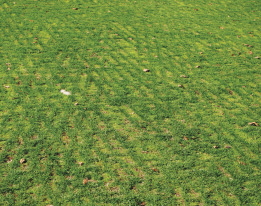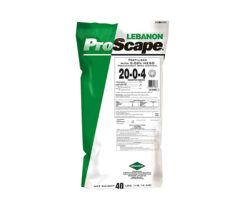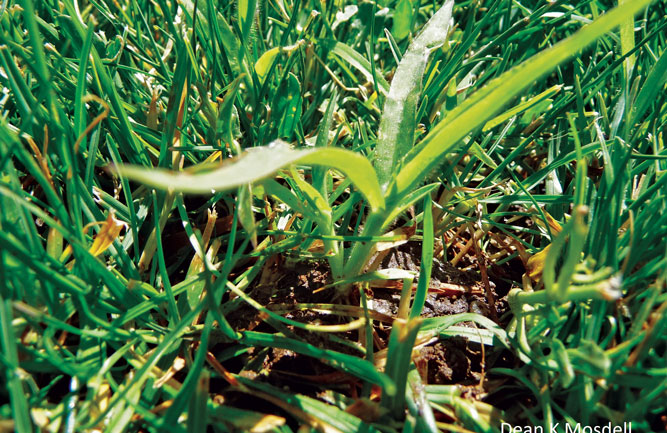Pre-emergent herbicides for golf turf
By Zac Reicher, Ph.D.
Little has changed in pre‑emergent herbicides (PREs) for use on cool-season turfgrasses over the last 20 years. The primary products for golf turf are still dithiopyr (Dimension, Dithiopyr), prodiamine (Barricade and others) and pendimethalin (Pendulum, PRE-M and others). Oxadiazon (Ronstar, Oxadiazon) is often used specifically for goosegrass control, while bensulide (Betasan, Bensumec) is still a standard for annual bluegrass control in greens-height creeping bentgrass.
Though formulations are always improving, some relatively recent changes include introduction of post-patent PREs as well as some pre-packaged mixes of active ingredients. Though the availability of PREs and application technology has changed very little in the last 20 years, effective and efficient use of PREs is still critical for golf courses across the country.
Crabgrass control
Most PREs are targeted for crabgrass, and the weather the last three summers has certainly tested efficacy of PREs for crabgrass control. Preemergent herbicides are most effective on dense, competitive turf stands that limit crabgrass. Tough summers not only thin cool-season turf, but warm soils and increased sunlight penetration into thin turf increases microbial and UV degradation of PREs.
Furthermore, staff and golfers can easily see the difference between 100 percent and 90 percent crabgrass control, so there is little room for marginal control. By their nature, PREs provide variable crabgrass control from year to year and among locations. The product and rate that worked really well last year may perform poorly this year, or vice versa. Or the product and rate that worked really well for the course down the street did not perform well for you.
The bottom line is that the PREs available today are all very effective, but efficacy can be affected by a multitude of factors, many of which we cannot predict or understand. Following are a few suggestions to maximize PRE efficacy on crabgrass and goosegrass.
Application timing: Many studies, including ours at Purdue University and the University of Nebraska-Lincoln (UNL), show that timing of PRE application can be in late fall (October-November in the north central states) or very early spring (February-March in the north central states) and still achieve season-long crabgrass control comparable to the traditional timing of mid-spring.
The benefit of late fall or very early spring applications is, they can be made well before spring’s mad dash of cleanup, constant mowing, and course opening. Though the data show it works, the traditional application timing of mid-spring still usually trends higher for crabgrass control than very early spring or late fall application. Therefore, higher PRE rates must be used for late fall and very early spring to maximize control.
Sequential applications: After working with PREs for 25 years, I am convinced that it is best to maximize crabgrass and goosegrass control with sequential applications. Depending on your location, two applications at one-half plus one-half the high use rate will usually suffice and will almost always improve crabgrass and goosegrass control over a single application at the high use rate. The second application is usually made 4-6 weeks after the first expected crabgrass germination, but the first application can be made at the traditional timing, late fall or very early spring.
Up until the last few years, we recommended using the same active ingredient for the initial and sequential applications. However, our recent research shows that when using one-half the high use rate for the initial and sequential application, it does not matter which active ingredient is used for the initial or sequential applications (Figure 1; we tested only dithiopyr, pendimethalin and prodiamine). This increases flexibility in product selection, allows use of remaining product from previous years/applications and could increase post-emergent herbicide (POST) control of breakthrough crabgrass if dithiopyr is used for the sequential application(s).
Watering-in: Though the label on all PREs (especially the sprayable formulations) clearly state that they should be watered-in within 24 to 48 hours after application, this recommendation is often ignored.
However, watering-in PREs immediately after application with 0.1 to 0.2 inches of water resulted in up to 50 percent improved crabgrass control in one of our studies on fairway-height Kentucky bluegrass in 2011 (Figure 2). Watering-in the PREs moves the active ingredient to the soil, where it can be effective and reduces loss through volatilization and UV degradation.
Use in new seeding
Hot, dry summers like 2012’s, followed by a dry fall, mandate either dormant seeding this winter or seeding next spring. Weed control in dormant or spring seedings is critical to limit crabgrass pressure in spring and summer. Most PREs cannot be used prior to seeding, and their use is delayed following seeding to limit damage to seedlings.
Dithiopyr has the most flexible label and can be applied after the second mowing of the seedlings. Tenacity (mesotrione) is especially useful over new seedlings of many cool-season turfgrass species (other than creeping bentgrass) because it provides excellent PRE control of crabgrass, annual bluegrass and many broadleaf weeds when applied immediately prior to seeding on bare soils.
However, Tenacity is not an effective PRE on turfed soils. Our research indicates aggressive use of herbicides after seeding may cause some short-term injury to the desired turf but is more than compensated in decreased weed pressure over the long term.
Annual bluegrass control
Post and growth regulators for annual bluegrass control have improved with new strategies and products, but annual bluegrass is best controlled with a multi-pronged approach. This is at least partly due to variability in annual bluegrass biotypes, where one biotype may be susceptible to a specific herbicide or growth regulator while the neighboring biotype is unaffected. As a winter annual, most annual bluegrass seed will germinate in fall. Thus, PREs applied for annual bluegrass control should be applied in late summer.
Previous research at Cornell University and our current research on creeping bentgrass, Kentucky bluegrass and/or perennial ryegrass fairways clearly show that including a late summer application of a PRE in combination with a program of POST herbicides improves annual bluegrass control over the POST program alone. If the PRE is not included, the tremendous bank of annual bluegrass seed in the soil will germinate all fall and quickly reoccupy any of the openings left by annual bluegrass controlled by the POST applications.
Using multiple modes of action in an annual bluegrass control program also can minimize the chances of developing a population resistant to a single mode of action approach.

After summer thinning of fairways containing annual bluegrass, overseeding desired turf (the dark green lines of perennial ryegrass in this case) is done to improve playability. However, annual bluegrass germinates quickly in the fall, re-occupying bare areas and likely out-competing the desired turf over the winter. Current research is evaluating the aggressive use of pre- and/or post-emergent herbicides to limit annual bluegrass reinfestation. Preliminary results are promising. Photo: Brian Silva
During summers like 2011 or 2012, turf stands of desired turf and/or annual bluegrass thin and die. The immediate response is to interseed the desired turf, but annual bluegrass germinates at the same time and starts to out-compete the desired turf again (Figure 3).
Options for using PREs in over-seeding are limited to applications after the seedlings have matured. Initial research results at UNL investigating the use of PREs applied prior to seeding to control the annual bluegrass between the overseeder slits and preliminary results are surprisingly positive. Our other research, partly funded by the USGA, is evaluating POSTs applied shortly after emergence of the desired turf to help minimize annual bluegrass. Simply overseeding into thin turf without aggressive annual bluegrass control will continue the cycle of annual bluegrass infesting the stand.
Yellow nutsedge control
Yellow nutsedge has long been controlled with POST applications, but PRE control has been documented from both Echelon (prodiamine plus sulfentrazone) and Tenacity. Applications of Echelon to established turf need to be at the typical PRE application timing for crabgrass of mid-spring and are most effective with sequential applications.
Tenacity can control yellow nut-
sedge PRE in a new seeding on bare soils. Though neither of these products provide 100 percent control of yellow nutsedge every time, their typical 70 to 90 percent control is far better than we ever expected from previous PRE applications.
Though few major changes have occurred in pre-emergent herbicides over the last 20 years, researchers continue to advance our understanding of these products, resulting in improved weed control and expanded uses in golf turf.
Zac Reicher, Ph.D., is a professor in the Department of Agronomy and Horticulture at the University of Nebraska-Lincoln. He can be reached at zreicher2@unl.edu.










